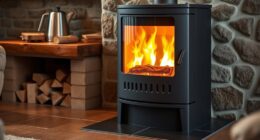
I’ve always been fascinated by the delightful warmth that radiates from a wood stove. But, have you ever wondered about how it’s able to generate heat?
In this article, we’ll delve into the intricate combustion process, explore the mechanisms of heat transfer, and gain a deeper understanding of flue gases.
We’ll also uncover the importance of air circulation and convection, as well as the factors that affect the wood stove’s heat output.
Get ready to unravel the secrets behind this humble yet powerful source of heat.

Key Takeaways
- Wood stoves utilize radiant heating, emitting heat in the form of electromagnetic waves.
- Proper insulation prevents heat loss and improves the efficiency of wood stoves.
- Wood stove design promotes convection, ensuring even distribution of heat throughout the room.
- Adequate airflow and fuel quality are crucial for efficient combustion and heat production.
The Combustion Process
I can feel the warmth radiating from the wood stove as it undergoes the combustion process. Wood stoves have come a long way in terms of efficiency improvements, ensuring that the heat generated is maximized and utilized effectively.
The combustion process begins when the wood is burned in the firebox. As the wood ignites, it releases heat energy in the form of flames and hot gases. These gases pass through the stove’s combustion chamber, where they’re mixed with air and burned at high temperatures. This combustion process allows for efficient heat production, with a significant reduction in smoke and pollutants emitted.
Wood stoves today are designed to minimize environmental impact by incorporating features such as secondary combustion systems and catalytic converters, which further enhance efficiency and reduce emissions. These advancements make wood stoves a viable and eco-friendly heating option.
Heat Transfer Mechanisms
As a user of a wood stove, I can feel the warmth radiating from the surface of the stove and circulating throughout the room. This is because wood stoves utilize radiant heating to transfer heat.

Radiant heating is a mechanism where heat is emitted in the form of electromagnetic waves. When the fire within the wood stove burns, it heats up the metal surface of the stove. The metal then emits infrared radiation, which travels in straight lines and heats objects and people in its path. This direct transfer of heat makes the room feel warm and cozy.
The effectiveness of radiant heating depends on the thermal conductivity of the materials involved. Metals, like the ones used in wood stoves, have high thermal conductivity, allowing them to quickly absorb and emit heat, making them excellent for radiant heating.
Understanding Flue Gases
The flue gases from the wood stove contain harmful pollutants that need to be properly vented to ensure indoor air quality. Understanding the composition of these flue gases and the design of the chimney is crucial for maintaining a safe and healthy environment. Here are four key points to consider:
Flue gas composition: Flue gases primarily consist of carbon dioxide, water vapor, and trace amounts of other pollutants such as carbon monoxide, sulfur dioxide, and particulate matter. These pollutants can have adverse effects on human health if not properly removed.

Combustion efficiency: The composition of flue gases can vary depending on factors like fuel quality, stove design, and combustion efficiency. Ensuring efficient combustion reduces the emission of harmful pollutants.
Chimney design: A well-designed chimney is essential for effective venting of flue gases. It should be properly insulated, have sufficient height, and be constructed with materials that can withstand high temperatures.
Regular maintenance: Regular cleaning and inspection of the chimney are necessary to prevent blockages and ensure proper venting. This helps maintain air quality and prevents the risk of chimney fires.
Air Circulation and Convection
To maintain a comfortable temperature indoors, I rely on the natural air circulation and convection created by my wood stove.

The key to efficient heating is understanding how air moves and the role insulation materials play in retaining heat. Insulation materials like fiberglass, cellulose, and foam help to minimize heat loss by providing a barrier between the warm air inside and the cold air outside.
They trap heat and prevent it from escaping, allowing the wood stove to effectively heat the space.
In addition, the design of the wood stove promotes convection, where hot air rises and circulates throughout the room. This process ensures even distribution of heat, making my wood stove an efficient and reliable source of warmth during the colder months.
Does Understanding How a Wood Stove Emits Heat Help in Operating It?
Understanding the operating a wood stove instructions is crucial for efficient use. Knowing how the wood stove emits heat helps in controlling and maximizing its warmth. Proper operation ensures safety and reduces fuel consumption, making the most of this eco-friendly heating option.
Factors Affecting Heat Output
When I adjust the damper on my wood stove, I can control the amount of heat that’s released into the room. This is just one of the factors that affect the heat distribution and efficiency of a wood stove.

Here are four other important factors to consider:
Insulation: Proper insulation around the stove and chimney can prevent heat loss and improve efficiency.
Stove design: The design of the stove, including the size and arrangement of the firebox and heat exchange surfaces, can impact how effectively heat is transferred to the room.
Airflow: Adequate airflow is crucial for efficient combustion. A well-designed stove will have adjustable air vents to control the amount of oxygen supplied to the fire.

Fuel quality: Using dry and seasoned firewood can significantly improve heat production and reduce smoke and creosote buildup.
Frequently Asked Questions
How Long Does It Take for a Wood Stove to Emit Heat After Starting a Fire?
After starting a fire in a wood stove, it typically takes around 15-30 minutes for the stove to emit heat. The design of the stove, such as its insulation and air flow, can affect the speed and efficiency of heat emission.
Can a Wood Stove Be Used as the Primary Source of Heat for a Home?
Yes, a wood stove can be used as the primary source of heat for a home. I know a family who installed a high-efficiency wood stove and reduced their heating costs significantly. The benefits include lower utility bills and a cozy, warm atmosphere.
Is It Safe to Leave a Wood Stove Unattended While It Is Emitting Heat?
It is not safe to leave a wood stove unattended while it is emitting heat. Safety precautions must be taken, such as ensuring proper ventilation and regularly checking the stove for any potential hazards.

What Are the Potential Health Risks Associated With Wood Stove Emissions?
Potential health risks associated with wood stove emissions include respiratory problems, such as asthma and bronchitis, due to the release of harmful pollutants like carbon monoxide and fine particulate matter. These emissions contribute to air pollution, which can have serious consequences for our well-being.
Can a Wood Stove Emit Heat Even When It Is Not Actively Burning Wood?
Yes, a wood stove can emit heat even when it’s not actively burning wood. This can happen due to residual heat from the previous fire, proper wood stove maintenance, and following best practices for wood stove operation.
Conclusion
So there you’ve it, folks. The wood stove, with its mesmerizing flames and cozy warmth, isn’t just a simple appliance. It’s a marvel of combustion, heat transfer, and air circulation.
From the crackling of the logs to the gentle waft of flue gases, it’s like a symphony of heat production.

So next time you cozy up by the wood stove, take a moment to appreciate the scientific marvel that’s keeping you toasty. It’s not just heat, it’s a work of art.
Growing up surrounded by the vast beauty of nature, Sierra was always drawn to the call of the wild. While others sought the comfort of the familiar, she ventured out, embracing the unpredictable and finding stories in the heartbeat of nature.
At the epicenter of every remarkable venture lies a dynamic team—a fusion of diverse talents, visions, and passions. The essence of Best Small Wood Stoves is crafted and refined by such a trio: Sierra, Logan, and Terra. Their collective expertise has transformed the platform into a leading authority on small wood stoves, radiating warmth and knowledge in equal measure.











